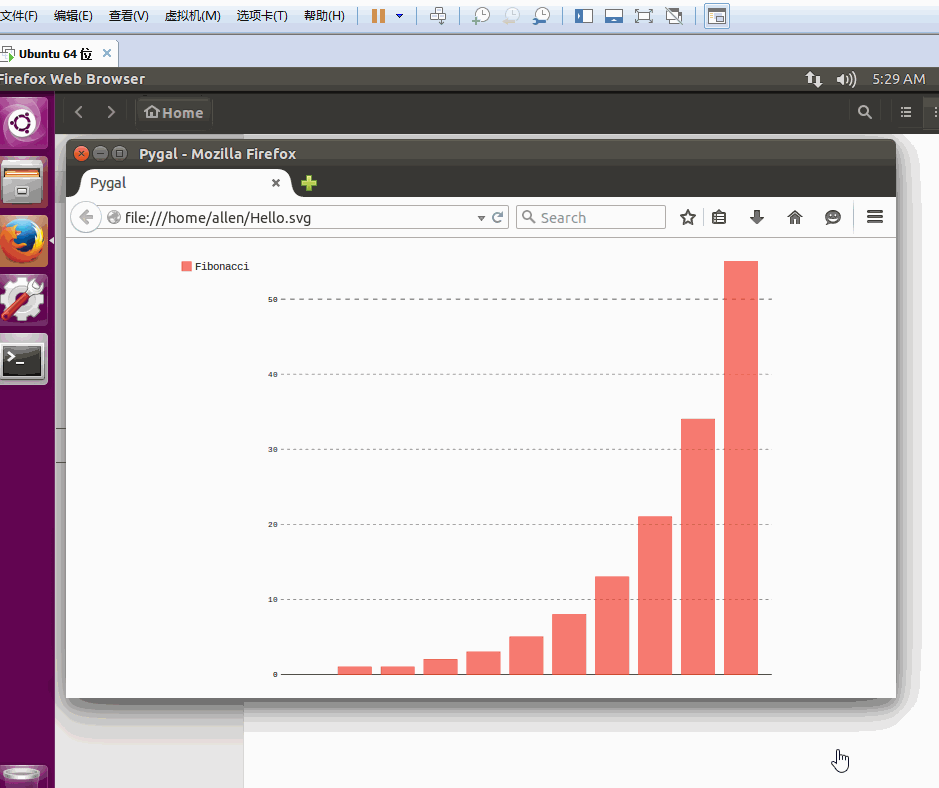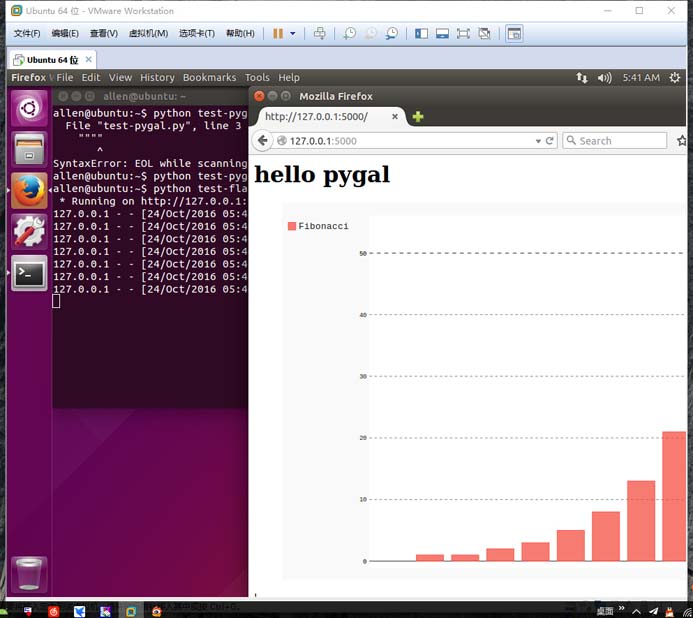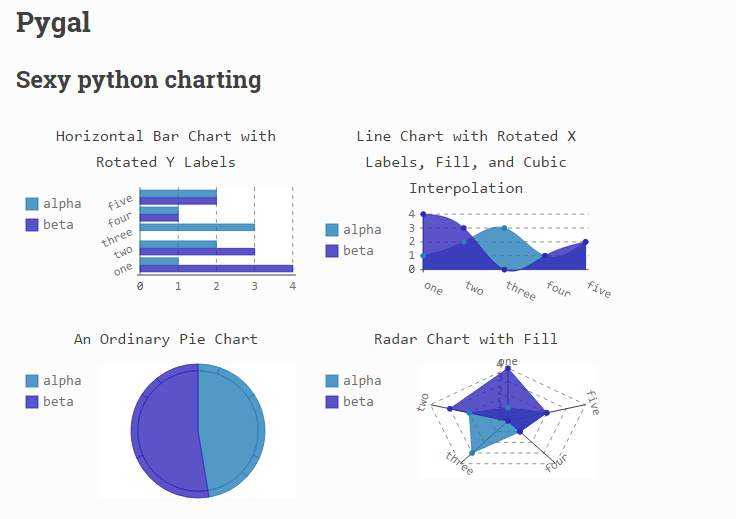 Backend Development
Backend Development
 Python Tutorial
Python Tutorial
 Detailed explanation of how to generate beautiful SVG images in python using Pygal
Detailed explanation of how to generate beautiful SVG images in python using Pygal
Detailed explanation of how to generate beautiful SVG images in python using Pygal
Preface
SVG can be regarded as the most popular image file format at present. Its full English name is Scalable Vector Graphics, which means scalable vector graphics. It is based on XML (Extensible Markup Language) and developed by the World Wide Web Consortium (W3C) alliance. Strictly speaking, it should be an open standard vector graphics language that allows you to design exciting, high-resolution web graphics pages. Users can directly use code to depict images, open SVG images with any word processing tool, make the images interactive by changing part of the code, and insert them into HTML at any time for viewing through a browser.
First Head in Pygal
First install pygal:
pip install pygal
If If you want to set the generated format to a format other than svg, such as png, jpg, etc., you need to install the following libraries:
pip install lxml
In In Ubuntu, you can install it according to the following prompts:
sudo apt-get install libxml2-dev libxslt1-dev python-dev sudo apt-get install python-lxml pip install cairosvg
The principle of installing this library is the same as above:
sudo apt-get install python-cairosvg
The following two libraries only need normal pip installation:
pip install tinycss pip install cssselect
##Hello SVG
import pygal bar_chart = pygal.Bar() bar_chart.add('Fibonacci', [0, 1, 1, 2, 3, 5, 8, 13, 21, 34, 55]) bar_chart.render_to_file('Hello.svg')

import pygal line_chart = pygal.Line() line_chart.title = 'Browser usage evolution (in %)' line_chart.x_labels = map(str, range(2002, 2013)) line_chart.add('Firefox', [None, None, 0, 16.6, 25, 31, 36.4, 45.5, 46.3, 42.8, 37.1]) line_chart.add('Chrome', [None, None, None, None, None, None, 0, 3.9, 10.8, 23.8, 35.3]) line_chart.add('IE', [85.8, 84.6, 84.7, 74.5, 66, 58.6, 54.7, 44.8, 36.2, 26.6, 20.1]) line_chart.add('Others', [14.2, 15.4, 15.3, 8.9, 9, 10.4, 8.9, 5.8, 6.7, 6.8, 7.5]) line_chart.render_to_file('Hello_line_chart.svg')

Hello PNG
import pygal bar_chart = pygal.Bar() bar_chart.add('Fibonacci', [0, 1, 1, 2, 3, 5, 8, 13, 21, 34, 55]) bar_chart.render_to_file('bar_chart.svg') # 生成 png 格式图表 bar_chart.render_to_png(filename='bar_chart.png')

Hello Flask and Pygal
pip install flask
import pygal from flask import Flask, Response app = Flask(__name__) @app.route('/') def index(): return """ <html> <body> <h1 id="hello-nbsp-pygal-nbsp-and-nbsp-flask">hello pygal and flask</h1> <figure> <embed type="image/svg+xml" src="/hellosvg/" /> </figure> </body> </html>' """ @app.route('/hellosvg/') def graph(): """ render svg graph """ bar_chart = pygal.Bar() bar_chart.add('Fibonacci', [0, 1, 1, 2, 3, 5, 8, 13, 21, 34, 55]) return Response(response=bar_chart.render(), content_type='image/svg+xml') if __name__ == '__main__': app.run()



Hot AI Tools

Undresser.AI Undress
AI-powered app for creating realistic nude photos

AI Clothes Remover
Online AI tool for removing clothes from photos.

Undress AI Tool
Undress images for free

Clothoff.io
AI clothes remover

Video Face Swap
Swap faces in any video effortlessly with our completely free AI face swap tool!

Hot Article

Hot Tools

Notepad++7.3.1
Easy-to-use and free code editor

SublimeText3 Chinese version
Chinese version, very easy to use

Zend Studio 13.0.1
Powerful PHP integrated development environment

Dreamweaver CS6
Visual web development tools

SublimeText3 Mac version
God-level code editing software (SublimeText3)

Hot Topics
 1662
1662
 14
14
 1418
1418
 52
52
 1311
1311
 25
25
 1261
1261
 29
29
 1234
1234
 24
24
 Python vs. C : Applications and Use Cases Compared
Apr 12, 2025 am 12:01 AM
Python vs. C : Applications and Use Cases Compared
Apr 12, 2025 am 12:01 AM
Python is suitable for data science, web development and automation tasks, while C is suitable for system programming, game development and embedded systems. Python is known for its simplicity and powerful ecosystem, while C is known for its high performance and underlying control capabilities.
 Python: Games, GUIs, and More
Apr 13, 2025 am 12:14 AM
Python: Games, GUIs, and More
Apr 13, 2025 am 12:14 AM
Python excels in gaming and GUI development. 1) Game development uses Pygame, providing drawing, audio and other functions, which are suitable for creating 2D games. 2) GUI development can choose Tkinter or PyQt. Tkinter is simple and easy to use, PyQt has rich functions and is suitable for professional development.
 The 2-Hour Python Plan: A Realistic Approach
Apr 11, 2025 am 12:04 AM
The 2-Hour Python Plan: A Realistic Approach
Apr 11, 2025 am 12:04 AM
You can learn basic programming concepts and skills of Python within 2 hours. 1. Learn variables and data types, 2. Master control flow (conditional statements and loops), 3. Understand the definition and use of functions, 4. Quickly get started with Python programming through simple examples and code snippets.
 How Much Python Can You Learn in 2 Hours?
Apr 09, 2025 pm 04:33 PM
How Much Python Can You Learn in 2 Hours?
Apr 09, 2025 pm 04:33 PM
You can learn the basics of Python within two hours. 1. Learn variables and data types, 2. Master control structures such as if statements and loops, 3. Understand the definition and use of functions. These will help you start writing simple Python programs.
 Python vs. C : Learning Curves and Ease of Use
Apr 19, 2025 am 12:20 AM
Python vs. C : Learning Curves and Ease of Use
Apr 19, 2025 am 12:20 AM
Python is easier to learn and use, while C is more powerful but complex. 1. Python syntax is concise and suitable for beginners. Dynamic typing and automatic memory management make it easy to use, but may cause runtime errors. 2.C provides low-level control and advanced features, suitable for high-performance applications, but has a high learning threshold and requires manual memory and type safety management.
 Python and Time: Making the Most of Your Study Time
Apr 14, 2025 am 12:02 AM
Python and Time: Making the Most of Your Study Time
Apr 14, 2025 am 12:02 AM
To maximize the efficiency of learning Python in a limited time, you can use Python's datetime, time, and schedule modules. 1. The datetime module is used to record and plan learning time. 2. The time module helps to set study and rest time. 3. The schedule module automatically arranges weekly learning tasks.
 Python: Exploring Its Primary Applications
Apr 10, 2025 am 09:41 AM
Python: Exploring Its Primary Applications
Apr 10, 2025 am 09:41 AM
Python is widely used in the fields of web development, data science, machine learning, automation and scripting. 1) In web development, Django and Flask frameworks simplify the development process. 2) In the fields of data science and machine learning, NumPy, Pandas, Scikit-learn and TensorFlow libraries provide strong support. 3) In terms of automation and scripting, Python is suitable for tasks such as automated testing and system management.
 Python: Automation, Scripting, and Task Management
Apr 16, 2025 am 12:14 AM
Python: Automation, Scripting, and Task Management
Apr 16, 2025 am 12:14 AM
Python excels in automation, scripting, and task management. 1) Automation: File backup is realized through standard libraries such as os and shutil. 2) Script writing: Use the psutil library to monitor system resources. 3) Task management: Use the schedule library to schedule tasks. Python's ease of use and rich library support makes it the preferred tool in these areas.



